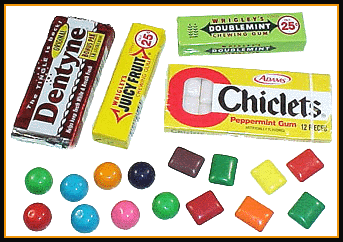
Where is the polymer in chewing gum?

Where did chewing gum originate?
A piece of chewing gum dating back 6,500 years (C&EN, March 24, 1997, page 64) from Bokeburg, Sweden is believed to be from a natural tar. Elizabeth Aveling, University of Bradford, England, analyzed it and thinks the source was birch bark. Tar from birch was used for waterproofing and glue as early as 4500 B.C. There were small teeth marks in the gum indicating that teenagers and younger children chewed the gum. Making birch bark gum in the modern laboratory, requires heating the bark in sealed containers without air present since the gum chars when heated in air. The methods that people of so long ago must have used remains a mystery.
The ancient Greeks chewed the resin from the mastic tree called mastiche (pronounced "mas-tee-ka"). The Maya Indians of Mexico chewed chicle which is resin from the sapodilla tree. American Indians of New England chewed the sap from the spruce tree. A colonist, John Curtis, in 1848 manufactured “State of Maine Pure Spruce Gum”. It was apparently not a very popular product because it tasted too much like spruce! Sweetened paraffin wax was his next product but it did not have the chewy nature of the spruce gum.What are the ingredients in chewing gum?In December of 1869, William Finely Semple of Mount Vernon, Ohio applied for a patent for making chewing gum from rubber and “other articles”. However, his product never entered the marketplace. In 1870, Thomas Adams, Sr. experimented with the sap from the Chiclezapote tree trying to make a rubber substitute. He never did find what he was looking for except he did accidentally discover that it was good to chew. By 1890, he had a factory in Staten Island, New York that employed 250 workers.
The chewing of gum became a huge craze. The New York Sun editorialized in 1890: “The habit has reached such a stage now that makes it impossible for a New Yorker to go to the theater or to church, or enter the street cars or the railway train, or walk on a fashionable promenade without meeting men and women whose jaws are working with the activity of the gum chewing victim. And the spectacle is maintained in the face of frequent reminders that gum-chewing, especially in public, is an essentially vulgar indulgence that not only shows bad breeding, but spoils a pretty continence and detracts from the dignity of those who practice the habit.”
Chewing gum consists of five main ingredients: a gum base, sugar, corn syrup, softeners, and flavorings. The gum base is the insoluble part left in the mouth while chewing and it is a polymer. The gum base is made of resins from trees, latexes or the milky juices from plants, and manmade polymers. If the gum base is chicle from the sapodilla tree, this product is being harvested in Belize, Mexico and Guatemala. Chicle is harvested from July to February which is during the rainy season. Slashes are cut into the bark of the tree so that the sap runs down the tree into a collection bucket.
Cuts on the sapodilla tree let the sap run into a collection bucket.
Thanks to Mexitrade Internacional, S.A. de C.V. for the use of this photo.
Chicle is boiled over an open fire in the rainforest to evaporate
some of the excess water. Once it is thick and taffy-looking, it
is packed into wooded forms to make blocks. These blocks are shipped
to some American chewing gum manufacturers. Chicle is a rubbery latex
or polyterpene. Polyterpenes are composed of thousands of C5H8 isoprene
subunits. Some of the original brands of packaged stick gums were
manufactured with chicle gum base.

Today, the gum base could also be made from styrene butadiene, poly(vinyl
acetate) or polyethylene. The sugar is for sweetening the product.
The corn syrup keeps the gum fresh and flexible. Softeners or fillers
such as vegetable oils help to blend the ingredients and retain moisture.
Sugarfree gum has sorbitol, mannitol, aspartame or saccharin instead of
sugar.
Who invented bubble gum?
Bubble gum was first produced in 1906 but it was not sold as a consumer product until 1928. The bubble gum base is firmer and more elastic than regular chewing gum.Laboratory Activity
Bubble gum’s polymer is a mixture of natural and synthetic gums and resins. Determine the percent gum base or polymer in a stick of gum by measuring its mass before chewing and after. This could be messy so set some strict parameters! Do all brands of bubble gum have the same percentage of polymer? Plan a procedure and design a data table before you begin.For more information on harvesting chicle look at this site: (www.chicle.com.mx/historia2.html)If you would like a complete bubble gum lab activity, there is one on the Macrogaleria Web Site. Click here for the activity.
This page designed by Mary Harris, Missouri Polymer Ambassador, email: mharris@jburroughs.org

PSLC OFFERS THIS SITE AS AN EDUCATIONAL TOOL. PSLC IS NOT RESPONSIBLE FOR ANY INJURY OR DAMAGE CAUSED TO ANY PERSON, DIRECTLY OR INDIRECTLY, RELATING TO ANY OF THE DEMOS OR EXPERIMENTS LISTED AT THIS SITE. YOU ARE WHOLLY RESPONSIBLE FOR YOUR SAFETY
Copyright ©2000 | Department of Polymer Science | University of Southern Mississippi